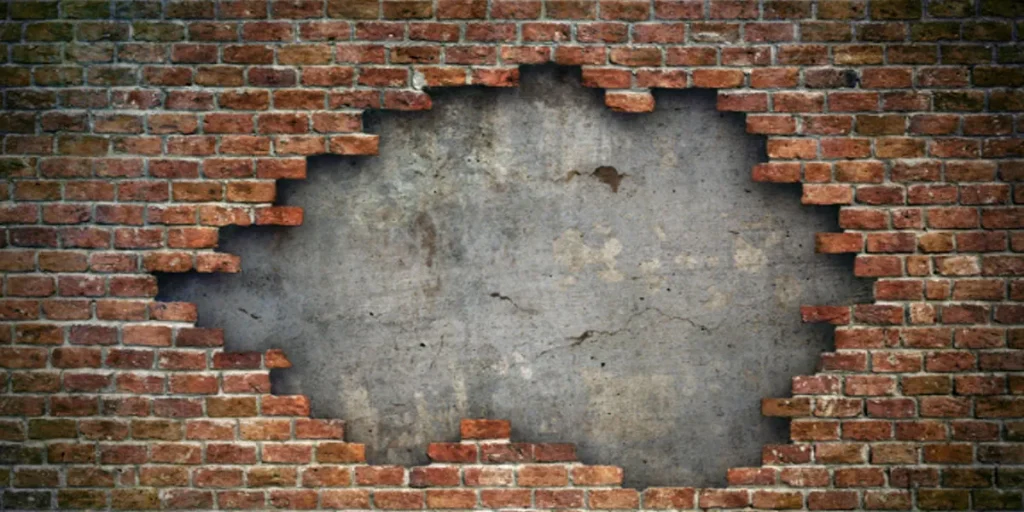The average weight of a standard brick is about 4.5 to 5 pounds. Standard bricks typically measure 7 5/8″ x 3 5/8″ x 2 1/4″.
Bricks have been fundamental in construction for centuries, valued for their durability and aesthetic appeal.
They are a staple in building materials, embodying versatility for various projects ranging from simple garden paths to grand architectural endeavors.
Constructed from ceramic, concrete, or other composite materials, the weight of a brick can vary slightly depending on its composition and size.
Builders often prefer bricks for their structural integrity and fire-resistant properties, offering an effective means of building sturdy, long-lasting structures.
The dimensions and weight are crucial for calculations of load-bearing walls and other structural considerations in construction planning.
Understanding the weight of individual bricks is vital for precise planning and logistics in construction projects, ensuring safety and efficiency at every stage of building.

Weight Of A Brick: Factors That Affect It
Understanding brick weight is crucial for various applications. From construction to shipping, the weight influences logistics and structural integrity.
Consider two primary factors: the material composition and the size or dimensions of the brick. Both determine the overall mass of a single unit.
Material Composition And Density
Bricks come in different materials, each with its own density. Density is mass per unit volume. The most common type is clay bricks.
They generally weigh between 3 to 5 pounds. On the other hand, concrete bricks can weigh more, typically from 5 to 10 pounds.
Other types include sand lime and engineered bricks which may vary in weight due to differing densities.
- Clay: Approximately 3-5 lbs
- Concrete: About 5-10 lbs
- Sand Lime: Varies
- Engineered Bricks: Weight depends on the materials used
Size And Dimensional Standards
Not all bricks are the same size, impacting their weight. Standard US bricks measure approximately 8 inches long, 3.5 inches wide, and 2.25 inches tall.
Sometimes, bricks can be larger or smaller based on the standards set by other countries or specialized construction requirements.
| Type | Dimensions (LxWxH) | Approx. Weight |
|---|---|---|
| Standard US Brick | 8″ x 3.5″ x 2.25″ | 4.5 lbs |
| UK Standard Brick | 8.5″ x 4″ x 2.5″ | 5 lbs |
| Modular Brick | 7.5″ x 3.5″ x 2.25″ | 4 lbs |
Different sizes lead to variations in weight. It is essential to know the type of brick to predict the weight accurately.
This information helps in estimating the number of bricks required and the total weight for any project.
Brick Varieties And Their Typical Weights

Understanding the weight of different types of bricks is crucial. It helps in construction planning. Many bricks exist. Each type has a unique weight.
Let’s explore the common bricks and their weights. This information will help in smart decision-making. Knowing these details ensures safety and effectiveness.
Common Brick Types: Clay, Concrete, And Fly Ash
Different brick types serve various purposes. Here, we touch on three popular types. We discuss their typical uses and benefits.
- Clay Bricks: Traditional and widely used for their classic appearance.
- Concrete Bricks: Stronger and weigh more than clay. Ideal for modern structures.
- Fly Ash Bricks: Eco-friendly and light. Made from industrial waste products.
Weight Comparisons Between Brick Classes
Each brick type has a different weight. The weight affects handling and transportation. Here’s a comparison.
| Brick Type | Average Weight |
|---|---|
| Clay Brick | 4.5 – 5.5 pounds |
| Concrete Brick | 5 – 7 pounds |
| Fly Ash Brick | 3 – 4 pounds |
Clay bricks are usually the lightest. Concrete bricks are heavier. Fly ash bricks are lightweight options.
Each brick serves a specific need in construction. The right choice depends on the weight and project requirements.
Role Of Brick Weight In Construction

Understanding brick weight is crucial for building strong and safe structures. The correct weight affects how a building holds up and supports loads.
Let’s dive into the significance of brick weight in the construction process.
Structural Integrity And Load Distribution
Bricks are key building blocks in construction. Builders must use bricks of the right weight to ensure a building’s longevity.
Structural integrity relies heavily on using bricks that can bear the load they’re meant to support.
- Heavier bricks can support more weight, vital for multi-story buildings.
- A consistent brick weight leads to equal load distribution.
- Uneven weight distribution from varied brick weights can cause structural issues.
Transportation And Handling Considerations
Brick weight also affects how workers handle and transport materials on-site. Health and safety standards limit the weight a person can safely carry.
Lighter bricks can mean fewer injuries and more efficient work.
| Brick Type | Average Weight | Handling Note |
|---|---|---|
| Standard Clay | 4.5 lbs | One hand carry |
| Heavy Clay | 6+ lbs | High strength required |
| Lightweight Aggregate | 3 lbs | Easier & safer to carry |
Proper equipment and planning for transport can save time and prevent injuries. Lighter bricks can reduce transport costs and minimize wear and tear on vehicles.
Yet, they must still meet performance and safety requirements.
Measuring The Mass: Techniques And Tools
Understanding the weight of a brick is vital in construction. Both industry professionals and DIY enthusiasts rely on accurate measurements to ensure the integrity of their structures.
Different techniques and tools make this process straightforward and precise. Let’s dive into the standard methods and on-site estimation techniques that are commonly used.
Standard Weighing Methods In Industry
Industrial scales are the go-to for precise measurements. Factories often use conveyor belt scales that weigh bricks in bulk.
For individual measurements, a digital bench scale does the job. With these tools, manufacturers maintain quality standards and packaging accuracy.
To ensure clear communication, values get noted in kilograms or pounds.
- Digital bench scales for individual bricks
- Conveyor belt scales for mass production
- Recording in kilograms or pounds
On-site Estimation Techniques For Professionals
On construction sites, professionals often need to estimate brick weight without scales. They use the size and material of the brick for a rough estimate.
- Identify brick type: clay or concrete
- Measure dimensions: length, width, height
- Calculate volume and use standard density values
This method is quick, with no need for heavy equipment. It also helps in managing resources efficiently and planning logistics.
The average weight of a standard brick is generally known, aiding in speedy calculations.
Environmental Impact Of Brick Weight
Brick weight matters more than many realize. It’s not just about the heft of a single brick, but the combined load and how it affects the environment.
Let’s dive into the impact of brick weight from production to its final place in construction.
Energy Consumption In Brick Production And Transport
Creating bricks requires significant energy. The kiln firing process alone is energy-intensive. After firing, these bricks travel long distances to reach construction sites.
The heavier the brick, the more fuel needed for transport. This results in higher greenhouse gas emissions.
- Manufacturing energy: High temperatures needed for long hours.
- Fuel for transport: Weight increases fuel consumption.
- Emissions: Larger transport carbon footprint.
Strategies For Minimalistic Design And Material Conservation
Architects and builders can embrace minimalistic designs. Using fewer materials can lower environmental impact.
Conservation methods include lighter bricks or alternative materials. Every saved ounce means a reduction in energy use and carbon emissions.
- Choose lightweight materials.
- Adopt energy-efficient designs.
- Reduce material waste on-site.
Innovative Trends: Lightweight Bricks And Eco-friendly Options
The world of construction constantly evolves with new, innovative solutions, especially within the realm of building materials.
Among these, lightweight bricks and eco-friendly options are game-changers. These advancements promise impressive benefits, from reduced environmental impact to easier handling and installation.
Development Of Lightweight Brick Solutions
The quest for lighter building materials has led to the creation of lightweight bricks.
These bricks don’t just ease the burden on construction workers but also mean lower transportation costs and reduced carbon emissions.
Innovators in the industry have developed various methods to shed the weight off traditional bricks.
- Use of alternative materials: By incorporating materials like fly ash or foam, bricks can be much lighter.
- Altering brick structure: The introduction of internal air pockets reduces weight without sacrificing strength.
- Size customization: Smaller bricks can be designed for specific uses, further reducing weight.
Adoption Of Sustainable Brick Alternatives
Eco-friendly bricks are rapidly becoming a cornerstone in sustainable construction.
These bricks are made of recycled materials, biodegradable substances, or those that require less energy to produce.
This approach not only reduces waste but also curtails energy consumption during production.
| Eco-Friendly Brick Type | Primary Material | Benefits |
|---|---|---|
| Recycled Bricks | Post-consumer waste | Reduces landfill, low energy use |
| Bio-based Bricks | Natural fibers | Biodegradable, renewable resource |
| Low-temperature Kiln Bricks | Traditional clay | Less energy in production |
These sustainable brick alternatives are not only good for the planet but also provide innovative solutions to architects and builders focused on green construction.
FAQs About the Weight of a Brick
What Is The Average Weight Of A Brick?
The average weight of a brick is typically around 4. 5 to 5 pounds. Standard red clay bricks, which are commonly used in construction, adhere to these weight ranges.
How Do Brick Weights Vary By Type?
Weights of bricks can vary depending on the material and size. For instance, a standard clay brick weighs about 4. 5 to 5 pounds, while a larger concrete brick can weigh more than 5 pounds.
Can Weather Affect A Brick’s Weight?
Weather can slightly affect a brick’s weight due to moisture absorption. Bricks are porous, meaning they can absorb water, which might increase their weight, but usually only temporarily and by a minimal amount.
Are Bricks Heavier Than Cinder Blocks?
Yes, bricks are generally heavier than cinder blocks when comparing similar volumes. A standard cinder block typically weighs around 28 pounds, which is much lighter than the combined weight of multiple bricks that occupy the same volume.
Conclusion
Understanding the weight of a brick is crucial for numerous construction projects. Standard red clay bricks tip the scales at about 4. 5-5 pounds, while heavier options exist for specific needs.
Remember, always consider the brick type for accurate weight calculations, aiding optimal design and structural integrity.
Resources:
https://www.energy.gov/eere/buildings/brick
https://www.gsa.gov/real-estate/historic-preservation/historic-preservation-policy-tools/preservation-tools-resources/technical-procedures/historic-early-brick-characteristics-uses-and-problems
